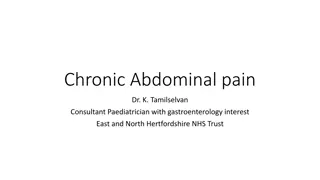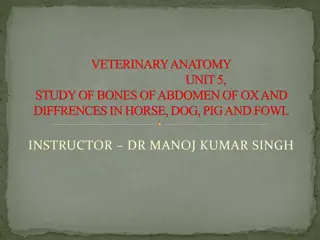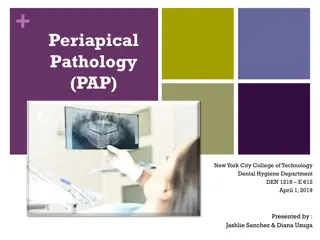Insect Abdominal Structures and Appendages: An Overview
The abdomen of insects plays crucial roles in respiration, reproduction, digestion, excretion, and metabolism. The number of abdominal segments varies across species, with reductions and modifications seen in different insect groups. From the propodeum to pregential and postgenital segments, each pa
1 views • 6 slides
Radiology Imaging Modalities for Renal System Evaluation
Various radiology modalities such as Ultrasound, X-Ray, MRI, CT, and Nuclear Scans are used to assess the renal system. Each modality has its advantages and disadvantages, with Ultrasound and MRI being radiation-free options, and Nuclear Scans providing functional assessment. Understanding the key f
6 views • 24 slides
Cardiopathies et Grossesse
Pendant la grossesse, l'appareil cardiovasculaire subit des modifications physiologiques importantes. Ces changements impactent l'accouchement et le post-partum, surtout chez les femmes souffrant de cardiopathies. Il est crucial de comprendre ces implications pour assurer la sécurité de la mère e
3 views • 12 slides
abdominal Sarcoma treatment specialist in Pune
Dr Manoj Dongare provides the best treatment for abdominal sarcomas. He is the best abdominal Sarcoma treatment specialist in Pune
0 views • 1 slides
Case Review: Diagnostic Dilemma in Urology - Management Approach for a Patient with Abdominal Pain and Fever
A 58-year-old man with a history of diabetes and hypertension presents with fever and abdominal pain, raising multiple differential diagnoses including symptomatic AAA, pyelonephritis, acute appendicitis, complicated urolithiasis, or diabetic ketoacidosis. The case explores clinical manifestations,
1 views • 35 slides
Understanding Central Abdominal Pain and Masses in Clinical Practice
Abdominal pain evaluation involves considering various differential diagnoses such as appendicitis, small bowel obstruction, and mesenteric ischemia. By categorizing pain as visceral, parietal, referred, or radiating, healthcare providers can better understand the underlying pathology. The history o
0 views • 57 slides
Exploring Abdominal Health: Diagnostic Journey of a Complex Case
In this detailed case study, a 37-year-old woman presents with abdominal distension and pain, leading to a diagnosis of a mucinous cystadenoma. Through advanced imaging techniques and surgical exploration, the medical team navigates the complexities of her condition, highlighting the challenges and
0 views • 11 slides
Understanding Fractures: Traumatic vs. Pathological and Modeling Options
Defining the distinction between traumatic and pathological fractures, exploring the relationship between non-traumatic fractures and underlying bone pathologies, and discussing modeling options for classifying fractures. Stress fractures, insufficiency fractures, and the causes of pathological frac
3 views • 8 slides
Understanding Chronic Abdominal Pain in Children: Causes, Diagnosis, and Treatment
Chronic abdominal pain in children is a common issue, with underlying organic diseases being relatively uncommon. Factors such as stress, parental anxiety, and genetic predisposition can contribute to these symptoms. It is crucial to differentiate between functional and organic GI disorders through
1 views • 28 slides
Comparative Study of Abdominal Bones in Various Animals
Study of the abdominal bones in the ox highlights characteristics like elongated transverse and curved articular processes, whereas differences in horse bones include shorter bodies and varying curvature of transverse processes. Understanding these anatomical variances provides insights into the uni
0 views • 16 slides
Understanding Hysteroscopes: A Comprehensive Guide
Hysteroscopy is a vital medical procedure for diagnosing intrauterine pathologies. This guide covers the history, components, and types of hysteroscopes, emphasizing rigid and flexible styles. It explains the significance of diameter, lens angles, and instrument options, showcasing images for better
1 views • 25 slides
Understanding the Peritoneum: Structure, Functions, and Inflammatory Responses
The peritoneum, a vital membrane in the body's abdominal cavity, consists of visceral and parietal components with distinct pain perceptions. It plays crucial roles in lubrication, fluid absorption, immune responses, and more. Peritoneal inflammatory exudate can result from various causes such as ba
0 views • 36 slides
Understanding Periapical Pathology in Dental Hygiene
Periapical pathology involves diseases around the tooth apex, such as abscesses, granulomas, cysts, and more. This presentation delves into identifying and differentiating these conditions, highlighting symptoms and radiographic features of each. Understanding these pathologies is crucial for dental
0 views • 12 slides
Addressing the Global Burden of Ageing-Related Pathologies: Strategies and Challenges
The presentation highlights the need for new policies to combat ageing-related pathologies, emphasizing the rising share of deaths due to non-communicable diseases globally. It covers the societal, professional, and biological aspects of ageing, along with legal considerations and initiatives for ag
2 views • 22 slides
Understanding Proper Abdominal Incision Techniques in Surgery
Proper abdominal incision techniques are crucial in surgical procedures to ensure successful outcomes. Factors such as skin tension lines, anatomical structures, cosmetic considerations, and procedural access must be carefully considered when planning and executing incisions. The use of appropriate
0 views • 29 slides
Understanding Periapical Pathology in Dentistry
Periapical pathology encompasses various conditions such as periapical abscess, granuloma, periodontal cyst, radicular cyst, and more. These pathologies result from different factors like infections, inflammation, or developmental issues. Identifying and treating these conditions is crucial in maint
0 views • 12 slides
Comprehensive Overview of Jaw Imaging Modalities and Pathologies
Comprehensive overview detailing jaw imaging modalities such as X-Ray, CT, and MRI for evaluating jaw bone and tooth conditions. Covers anatomy, common mandibular lesions, odontogenic cysts, non-odontogenic cysts, and odontogenic benign tumors. Provides details on diagnostic protocols, imaging findi
0 views • 7 slides
Veterinary Parasitology Flies: Identification and Pathologies
This content covers information related to veterinary parasitology focusing on flies, their scientific names, common names, characteristics, and pathologies associated with them. It also includes details on types of myiasis, bot characteristics, and filth fly characteristics, providing a comprehensi
0 views • 8 slides
Understanding Abdominal Trauma: Epidemiology, Mechanism, Evaluation & Management
Abdominal trauma is a significant concern, notably in road traffic accidents. Blunt abdominal trauma (BAT) accounts for a majority of cases, with injuries commonly affecting the spleen and liver. Various mechanisms of injury and evaluation techniques, including examination signs and lab tests, aid i
0 views • 12 slides
Parenteral Nutrition in Intestinal Failure Related to Advanced Abdominal Cancer
Discussion on parenteral nutrition in patients with intestinal failure secondary to advanced abdominal cancer, including considerations for patient selection, Christie referral pathway, and practicalities of home parenteral nutrition. The background highlights the increasing commonality of home pare
0 views • 40 slides
Comprehensive Overview of Inguinal Hernia: Anatomy, Presentation, and Treatment
Inguinal hernia is characterized by an abnormal protrusion of viscus or a part of it through a weak point in the abdominal wall. It involves the anatomy of the inguinal region, including the superficial and deep inguinal rings, inguinal canal boundaries, and defense mechanisms. The anatomical classi
0 views • 37 slides
Comprehensive Guide to Abdominal Assessment for Healthcare Professionals
This lecture by Hassanain Mohammed Kadhim covers the essential techniques and subjective data needed for a thorough abdominal assessment. It includes objectives, equipment required, preparation steps, subjective data collection, inspection guidelines, abdominal landmarks, common causes of abdominal
0 views • 21 slides
Understanding Foot Pathologies: Traumatic Injuries and Pressure Injuries
Explore common foot pathologies including traumatic injuries like plantar fasciitis, turf toe, and sprains, as well as pressure injuries such as plantar ulcers and heel spurs. Learn about the causes, symptoms, and treatment options for these conditions.
0 views • 33 slides
Transforming Spinal Pathology Care: Belgian Registry Startup Journey
Experience the journey of establishing a national registry for spinal pathologies in Belgium, led by Johan G. Van Lerbeirghe. Explore the goals, history, and the significance of choosing Spine Tango as the registry platform. Witness the challenges, partnerships, and milestones in the Belgian Pilot p
0 views • 14 slides
Understanding Chronic Functional Abdominal Pain: Clinical Diagnosis and Management
Chronic functional abdominal pain is characterized by persistent discomfort lasting over three months, with various underlying causes such as gastrointestinal disorders, genitourinary issues, and miscellaneous conditions. Diagnosis involves differential assessment and recognizing functional disorder
0 views • 26 slides
Evaluation and Management of Pediatric Intoeing: A Comprehensive Guide
Evaluation and treatment of pediatric intoeing involves a detailed history, screening examinations, and special tests to assess rotational profiles and identify underlying pathologies such as femoral anteversion, tibial torsion, and forefoot adduction. Proper diagnosis and education of parents are c
0 views • 66 slides
Understanding the Anatomy and Histology of the Conjunctiva
This educational content explores the intricate details of the conjunctiva, a thin mucous membrane that lines the inner surface of the eyelids and globe. Topics include anatomical divisions, histological features such as epithelium and stroma, and common microbial conjunctival pathologies like bacte
0 views • 51 slides
Ultrasound Rounds: Clinical Case Study of 31-Year-Old Female with Abdominal Pain
31-year-old female presents to the emergency department with sudden onset severe abdominal pain localized to the RLQ. Her clinical history and examination findings are detailed, along with lab results showing positive beta-hCG. Ultrasound examination techniques including transabdominal and transvagi
0 views • 32 slides
Comprehensive Guide to Abdominal Assessment Methods
Learn the critical order of examination for abdominal assessment, including inspection, auscultation, percussion, and palpation. Understand how to assess skin characteristics, symmetry, abdominal muscles, bowel sounds, vascular sounds, organ size, and tenderness. Discover techniques to identify abno
0 views • 72 slides
Abdominal Wall Defects: Omphalocele and Gastroschisis Overview
Abdominal wall defects such as omphalocele and gastroschisis are congenital conditions where abdominal organs protrude through an unusual opening in the abdomen. These defects result from disruptions during embryonic development, leading to serious implications for affected individuals. Different ty
1 views • 42 slides
Understanding Visual Pathways and Optic Nerve Disorders
Explore the anatomy of visual pathways, optic nerve anomalies, and various pathologies like coloboma, papilledema, and neuropathies. Discover images depicting normal and abnormal optic disc findings, providing insights into diagnosis and management of visual disorders.
0 views • 21 slides
Comprehensive Radiological Imaging Review in Abdominal and Adrenal Pathologies
This extensive radiological imaging review covers a wide range of topics in abdominal and adrenal pathologies, discussing differential diagnoses, imaging modalities such as CT and USG, specific syndromes like prune belly syndrome, and conditions like retroperitoneal fibrosis. It delves into various
0 views • 39 slides
Abdominal Pain, Jaundice & Abnormal Liver Function Tests in an 8-Year-Old Boy
An 8-year-old boy presents with intermittent abdominal pain that occurs before breakfast and sometimes at school, relieved by activities. He also exhibits jaundice and abnormal liver function tests, indicating a potential underlying liver issue. Immediate medical evaluation is necessary to diagnose
0 views • 33 slides
Understanding Appendicitis: Causes, Symptoms, and Diagnosis
Appendicitis is a common cause of acute abdominal pain requiring surgical intervention. It predominantly affects individuals between 10 to 20 years, with abdominal pain being a key symptom. Diagnosis often involves imaging tests such as CT scans or ultrasound, along with physical examinations like R
0 views • 17 slides
Necrotizing Enterocolitis: Causes, Symptoms, Diagnosis, and Treatment
Necrotizing Enterocolitis (NEC) is a serious condition affecting mainly premature infants, with unknown exact causes but potential risk factors like impaired mucosal barrier and feeding issues. Clinical manifestations include feeding intolerance, abdominal distention, and blood in stools. Diagnosis
0 views • 23 slides
Diagnostic Methods for Gastrointestinal Diseases: A Comprehensive Overview
Explore various diagnostic methods for gastrointestinal diseases, including laboratory investigations, abdominal ultrasound features, and radiology techniques. Learn about the significance of different tests such as ESR, blood count, liver tests, and abdominal ultrasound in diagnosing conditions aff
0 views • 40 slides
Inguinal Bubo and Genital Ulcer: Syndromic Approach by Dr. Rohit Kumar Singh
This informative content discusses the syndromic approach to managing inguinal bubo, genital ulcers, urethral discharge, scrotal swelling, vaginal discharge, lower abdominal pain, and neonatal conjunctivitis. It includes recommended treatment regimens for lower abdominal pain and emphasizes the impo
0 views • 140 slides
Mammary Gland Pathologies in Mares: Overview & Treatment
This detailed guide explores various pathologies of the mammary gland in mares, including galactorrhea, mastitis, agalactia, and lactation induction. It covers causes, clinical signs, diagnosis, and treatment options for each condition, providing valuable insights for equine healthcare professionals
0 views • 14 slides
Understanding Irritable Bowel Syndrome and Its Pathophysiology
Irritable bowel syndrome (IBS) is a common gastrointestinal disorder characterized by chronic abdominal pain and altered bowel habits. Despite the absence of organic causes, patients experience symptoms such as abdominal distention, bloating, and visceral hypersensitivity. The pathophysiology of IBS
0 views • 19 slides
Radiology of the abdomen
Abdominal radiology plays a crucial role in diagnosis using modalities such as X-ray, fluoroscopy, ultrasound, CT scan, and MRI. This technology helps assess conditions like bowel obstructions, calcifications, and more. Interpreting the gas patterns, diameters, and signs seen in abdominal imaging is
0 views • 47 slides







































